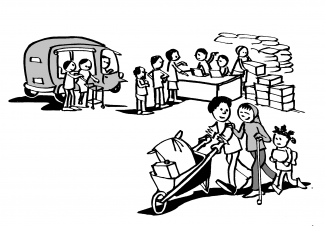Transportation
While designing, implementing and managing any kind of emergency response, it is important to consider how people with different needs and capabilities will have to use the environment, which include issues of transportation and mobility. All services and facilities should be easy to reach for everyone.
- During assessments, to increase people’s participation to focus group discussions or meetings, include safe, accessible and reliable means for transportation and mobility where needed. This will enable persons with disabilities, older persons, women and girls and children to participate safely and without obstacles;
- Identify the requirements of persons with disabilities to access services outside the camp, settlement or urban centre and provide support with transportation where necessary (including through the use of additional cash transfer for them);
- Keep in mind that women and girls with disabilities have to be able to travel safe and might need accompaniment in some cases;
- When public transport is available and accessible, identify if they stop at the facilities and services you provide or support , such as: distribution points, health services, collective centers, ATM or other Point of Sale terminals, schools, markets, water points etc.;
- During distribution, as shelter, water, food and non-food items can be large and heavy, provide home delivery to persons with disabilities who need it;
- Facilitation could also be provided via a buddy system (personal assistant - can be for few hours per day).

©Julie Smith
Sources
IFRC, CBM and HI. All Under One Roof. Disability-Inclusive shelters and settlements in emergencies. IFRC. 2015.